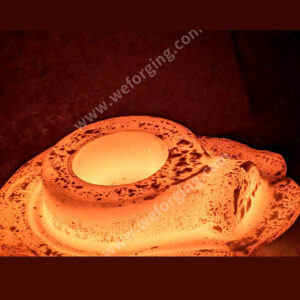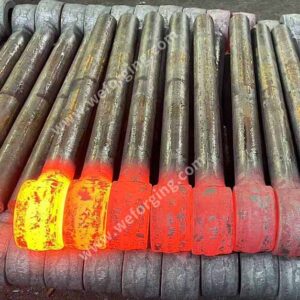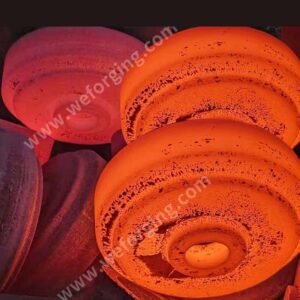Comprehensive Guide to Metal Forming Processes: Classification and Applications
Metal forming encompasses several key manufacturing techniques, each with distinct characteristics and industrial applications:
1.Forging
A precision process where heated metal billets (typically round steel bars) undergo plastic deformation under mechanical pressure. Primary methods include:
Free Forging – Open-die forming for custom shapes
Die Forging – High-precision mold-based forming
Ring Forging – Specialized for circular components
2.Casting
Involves pouring molten metal into molds for solidification. Common variants:
Investment Casting (Lost Wax) – For complex, high-precision parts
Sand Casting – Cost-effective for large components
Die Casting – High-volume production of thin-walled parts
3.Stamping
Sheet metal processing technique that utilizes dies to:
Cut/blank materials to specified shapes
Form complex geometries through pressure application
4.Cold Extrusion
A room-temperature process combining hydraulic presses with tooling (e.g., hex wrench dies) to:
Achieve net-shape forming
Enhance material strength through work hardening
5.Rolling
Continuous deformation process producing:
Structural profiles (bars, rods)
Flat products (plates, sheets)
Specialized components (ring flanges, seamless pipes)
6.Drawing
Precision sizing technique where billets are pulled through dies to:
Reduce cross-sections
Improve surface finish (e.g., precision-drawn tubes)
Superior Advantages of Forged Metal Components
2.1 Enhanced Mechanical Performance
Forged components deliver exceptional strength and durability through:
Optimized material density – Eliminates internal defects
Improved structural integrity – Enhances toughness and fatigue resistance
Superior load-bearing capacity – Ideal for high-stress applications
2.2 Unmatched Reliability
Forging process ensures:
100% defect-free microstructure – No porosity or shrinkage cavities
Consistent quality – Perfect for critical load-bearing components
Proven performance – Trusted for transmission shafts and rotary support rings
2.3 Production Stability
Die forging advantages include:
Complex geometry capability – Precise dimensional accuracy
Mass production suitability – Automotive industry standard
Long-term consistency – Maintains tight tolerances over production runs
2.4 Sustainable Manufacturing
Forging provides material efficiency:
Near-net-shape production – Minimizes raw material waste
Superior to machining – Reduces energy-intensive cutting processes
Cost-effective – Lowers overall production expenses
The Critical Role of Heat Treatment in Forging Processes
Heat treatment is an essential post-forging operation that significantly enhances component performance through advanced thermal processing techniques:
1. Internal Stress Relief
Annealing/Normalizing Processes
Eliminates residual forging stresses
Improves material stability and dimensional accuracy
2.Tempering Treatment (Quenching + Tempering)
Optimizes mechanical properties:
✓ Strength-to-toughness balance
✓ Fatigue resistance enhancementCritical for high-performance components: gears, shafts, and drivetrain parts
3.Surface Hardening (Carburizing & Nitriding)
Creates ultra-hard surface layers while maintaining:
✓ Tough core properties
✓ Wear-resistant surfacesIdeal for low-carbon steel gears requiring extreme durability
4.Machinability Improvement
Spheroidizing Annealing specifically:
✓ Reduces material hardness
✓ Optimizes cutting tool life
✓ Enables precision machining of complex geometries
Optimized Metal Forging Process Flow for Superior Quality Components
1. Material Preparation
Precision Cutting: Sawing or cutting raw stock to required dimensions
2. Thermal Preparation
Controlled Heating:
Heating to 1100-1200°C (steel recrystallization range)
Ensures optimal plasticity for forming
3. High-Precision Forming
Die Forging Process:
Mold-based forming for mass production
Delivers tight tolerances (±0.1mm)
4. Post-Forming Processing
Flash Removal:
Cutting and punching to eliminate burrs
Improves surface finish
5. Performance Enhancement
Custom Heat Treatment:
Normalizing and quenching per application requirements
Tailors mechanical properties
6. Final Machining
Precision Finishing:
Turning and grinding to exact dimensions
Achieves Ra 0.4μm surface finish
7. Gear Manufacturing
Specialized Tooth Cutting:
Hobbing and shaping for initial tooth profile
Shaving and grinding for final precision
8. Quality Assurance
Comprehensive Inspection:
NDT (UT/MT) for flaw detection
Hardness testing (HRC/HRB)
Dimensional verification
Advanced Quality Control System for Forged Components
1.Rigorous Material Verification
Chemical Composition Analysis – Spectral testing ensures material grade compliance
Metallographic Examination – Microscopic inspection verifies grain structure integrity
Traceability Assurance – Full material certification for production consistency
2.Precision Process Optimization
Mechanical Property Testing – Tensile and impact tests validate forging parameters
Heat Treatment Calibration – Customized thermal cycles for optimal performance
Production Parameter Adjustment – Real-time optimization of manufacturing variables
3.Comprehensive Quality Monitoring
Automated Furnace Tracking – Continuous temperature and time monitoring
Batch Hardness Control – Maintains ±2HRC tolerance across production runs
Dimensional Accuracy – Ensures <0.1mm deviation for critical dimensions
4.Corrosion Resistance Validation
Salt Spray Testing – ASTM B117 standard corrosion evaluation
Environmental Simulation – Marine condition testing for ship components
Surface Protection Verification – Validates anti-rust treatments effectiveness
Comprehensive Flaw Detection for Critical Metal Components
Essential Applications of Non-Destructive Testing (NDT):
Defect Identification & Analysis
Detects internal flaws including cracks, inclusions, folds, and porosity
Reveals microstructural abnormalities in forged components
Safety Assurance for Critical Applications
Mandatory for aerospace, nuclear, and bridge construction components
Ensures zero-defect performance in pressure vessels and load-bearing structures
Manufacturing Process Validation
Verifies product integrity after forging and heat treatment
Provides quality benchmarks for production optimization
Regulatory Compliance
Meets stringent international standards:
ISO 5817 (Welding standards)
ASME Boiler and Pressure Vessel Code
ASTM E1444 (Magnetic Particle Testing)
Advanced NDT Methodologies:
Ultrasonic Testing (UT)
Depth penetration up to 10 meters
Identifies subsurface flaws in thick sections
Ideal for turbine shafts and large forgings
Magnetic Particle Testing (MT)
Detects surface/near-surface defects
Exclusive for ferromagnetic materials
Sensitivity to 0.1mm cracks
Liquid Penetrant Testing (PT)
Reveals surface-breaking defects
Suitable for non-porous metals and ceramics
Complies with ASME Section V requirements
Radiographic Testing (RT)
3D defect visualization capability
Critical for weld inspection
Digital radiography advancements for higher resolution
Through the above links, the forging process can take into account performance and reliability, and become one of the core technologies of high-end manufacturing.







